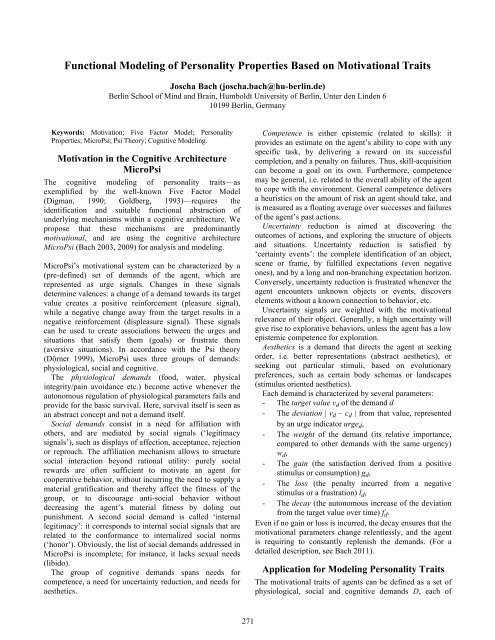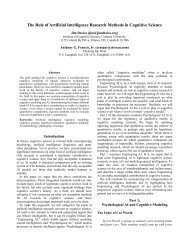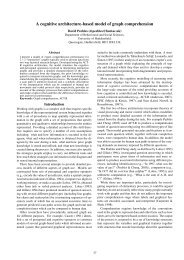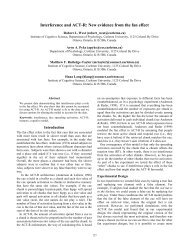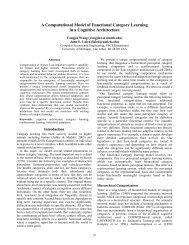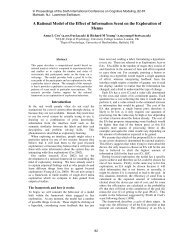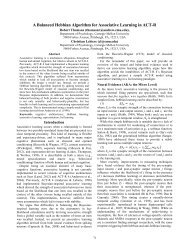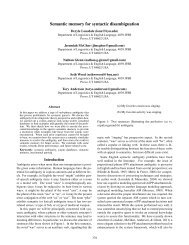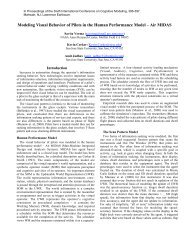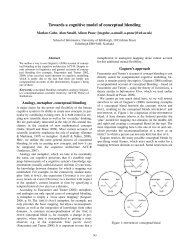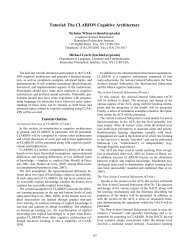Functional Modeling of Personality Properties Based on Motivational ...
Functional Modeling of Personality Properties Based on Motivational ...
Functional Modeling of Personality Properties Based on Motivational ...
Create successful ePaper yourself
Turn your PDF publications into a flip-book with our unique Google optimized e-Paper software.
<str<strong>on</strong>g>Functi<strong>on</strong>al</str<strong>on</strong>g> <str<strong>on</strong>g>Modeling</str<strong>on</strong>g> <str<strong>on</strong>g>of</str<strong>on</strong>g> <str<strong>on</strong>g>Pers<strong>on</strong>ality</str<strong>on</strong>g> <str<strong>on</strong>g>Properties</str<strong>on</strong>g> <str<strong>on</strong>g>Based</str<strong>on</strong>g> <strong>on</strong> Motivati<strong>on</strong>al TraitsJoscha Bach (joscha.bach@hu-berlin.de)Berlin School <str<strong>on</strong>g>of</str<strong>on</strong>g> Mind and Brain, Humboldt University <str<strong>on</strong>g>of</str<strong>on</strong>g> Berlin, Unter den Linden 610199 Berlin, GermanyKeywords: Motivati<strong>on</strong>; Five Factor Model; <str<strong>on</strong>g>Pers<strong>on</strong>ality</str<strong>on</strong>g><str<strong>on</strong>g>Properties</str<strong>on</strong>g>; MicroPsi; Psi Theory; Cognitive <str<strong>on</strong>g>Modeling</str<strong>on</strong>g>.Motivati<strong>on</strong> in the Cognitive ArchitectureMicroPsiThe cognitive modeling <str<strong>on</strong>g>of</str<strong>on</strong>g> pers<strong>on</strong>ality traits—asexemplified by the well-known Five Factor Model(Digman, 1990; Goldberg, 1993)—requires theidentificati<strong>on</strong> and suitable functi<strong>on</strong>al abstracti<strong>on</strong> <str<strong>on</strong>g>of</str<strong>on</strong>g>underlying mechanisms within a cognitive architecture. Wepropose that these mechanisms are predominantlymotivati<strong>on</strong>al, and are using the cognitive architectureMicroPsi (Bach 2003, 2009) for analysis and modeling.MicroPsi’s motivati<strong>on</strong>al system can be characterized by a(pre-defined) set <str<strong>on</strong>g>of</str<strong>on</strong>g> demands <str<strong>on</strong>g>of</str<strong>on</strong>g> the agent, which arerepresented as urge signals. Changes in these signalsdetermine valences: a change <str<strong>on</strong>g>of</str<strong>on</strong>g> a demand towards its targetvalue creates a positive reinforcement (pleasure signal),while a negative change away from the target results in anegative reinforcement (displeasure signal). These signalscan be used to create associati<strong>on</strong>s between the urges andsituati<strong>on</strong>s that satisfy them (goals) or frustrate them(aversive situati<strong>on</strong>s). In accordance with the Psi theory(Dörner 1999), MicroPsi uses three groups <str<strong>on</strong>g>of</str<strong>on</strong>g> demands:physiological, social and cognitive.The physiological demands (food, water, physicalintegrity/pain avoidance etc.) become active whenever theaut<strong>on</strong>omous regulati<strong>on</strong> <str<strong>on</strong>g>of</str<strong>on</strong>g> physiological parameters fails andprovide for the basic survival. Here, survival itself is seen asan abstract c<strong>on</strong>cept and not a demand itself.Social demands c<strong>on</strong>sist in a need for affiliati<strong>on</strong> withothers, and are mediated by social signals (‘legitimacysignals’), such as displays <str<strong>on</strong>g>of</str<strong>on</strong>g> affecti<strong>on</strong>, acceptance, rejecti<strong>on</strong>or reproach. The affiliati<strong>on</strong> mechanism allows to structuresocial interacti<strong>on</strong> bey<strong>on</strong>d rati<strong>on</strong>al utility: purely socialrewards are <str<strong>on</strong>g>of</str<strong>on</strong>g>ten sufficient to motivate an agent forcooperative behavior, without incurring the need to supply amaterial gratificati<strong>on</strong> and thereby affect the fitness <str<strong>on</strong>g>of</str<strong>on</strong>g> thegroup, or to discourage anti-social behavior withoutdecreasing the agent’s material fitness by doling outpunishment. A sec<strong>on</strong>d social demand is called ‘internallegitimacy’: it corresp<strong>on</strong>ds to internal social signals that arerelated to the c<strong>on</strong>formance to internalized social norms(‘h<strong>on</strong>or’). Obviously, the list <str<strong>on</strong>g>of</str<strong>on</strong>g> social demands addressed inMicroPsi is incomplete; for instance, it lacks sexual needs(libido).The group <str<strong>on</strong>g>of</str<strong>on</strong>g> cognitive demands spans needs forcompetence, a need for uncertainty reducti<strong>on</strong>, and needs foraesthetics.Competence is either epistemic (related to skills): itprovides an estimate <strong>on</strong> the agent’s ability to cope with anyspecific task, by delivering a reward <strong>on</strong> its successfulcompleti<strong>on</strong>, and a penalty <strong>on</strong> failures. Thus, skill-acquisiti<strong>on</strong>can become a goal <strong>on</strong> its own. Furthermore, competencemay be general, i.e. related to the overall ability <str<strong>on</strong>g>of</str<strong>on</strong>g> the agentto cope with the envir<strong>on</strong>ment. General competence deliversa heuristics <strong>on</strong> the amount <str<strong>on</strong>g>of</str<strong>on</strong>g> risk an agent should take, andis measured as a floating average over successes and failures<str<strong>on</strong>g>of</str<strong>on</strong>g> the agent’s past acti<strong>on</strong>s.Uncertainty reducti<strong>on</strong> is aimed at discovering theoutcomes <str<strong>on</strong>g>of</str<strong>on</strong>g> acti<strong>on</strong>s, and exploring the structure <str<strong>on</strong>g>of</str<strong>on</strong>g> objectsand situati<strong>on</strong>s. Uncertainty reducti<strong>on</strong> is satisfied by‘certainty events’: the complete identificati<strong>on</strong> <str<strong>on</strong>g>of</str<strong>on</strong>g> an object,scene or frame, by fulfilled expectati<strong>on</strong>s (even negative<strong>on</strong>es), and by a l<strong>on</strong>g and n<strong>on</strong>-branching expectati<strong>on</strong> horiz<strong>on</strong>.C<strong>on</strong>versely, uncertainty reducti<strong>on</strong> is frustrated whenever theagent encounters unknown objects or events, discoverselements without a known c<strong>on</strong>necti<strong>on</strong> to behavior, etc.Uncertainty signals are weighted with the motivati<strong>on</strong>alrelevance <str<strong>on</strong>g>of</str<strong>on</strong>g> their object. Generally, a high uncertainty willgive rise to explorative behaviors, unless the agent has a lowepistemic competence for explorati<strong>on</strong>.Aesthetics is a demand that directs the agent at seekingorder, i.e. better representati<strong>on</strong>s (abstract aesthetics), orseeking out particular stimuli, based <strong>on</strong> evoluti<strong>on</strong>arypreferences, such as certain body schemas or landscapes(stimulus oriented aesthetics).Each demand is characterized by several parameters:- The target value v d <str<strong>on</strong>g>of</str<strong>on</strong>g> the demand d- The deviati<strong>on</strong> | v d – c d | from that value, representedby an urge indicator urge d ,- The weight <str<strong>on</strong>g>of</str<strong>on</strong>g> the demand (its relative importance,compared to other demands with the same urgency)w d ,- The gain (the satisfacti<strong>on</strong> derived from a positivestimulus or c<strong>on</strong>sumpti<strong>on</strong>) g d ,- The loss (the penalty incurred from a negativestimulus or a frustrati<strong>on</strong>) l d ,- The decay (the aut<strong>on</strong>omous increase <str<strong>on</strong>g>of</str<strong>on</strong>g> the deviati<strong>on</strong>from the target value over time) f d .Even if no gain or loss is incurred, the decay ensures that themotivati<strong>on</strong>al parameters change relentlessly, and the agentis requiring to c<strong>on</strong>stantly replenish the demands. (For adetailed descripti<strong>on</strong>, see Bach 2011).Applicati<strong>on</strong> for <str<strong>on</strong>g>Modeling</str<strong>on</strong>g> <str<strong>on</strong>g>Pers<strong>on</strong>ality</str<strong>on</strong>g> TraitsThe motivati<strong>on</strong>al traits <str<strong>on</strong>g>of</str<strong>on</strong>g> agents can be defined as a set <str<strong>on</strong>g>of</str<strong>on</strong>g>physiological, social and cognitive demands D, each <str<strong>on</strong>g>of</str<strong>on</strong>g>271
them annotated by a tuple (w d , g d , l d , f d ), describing theweight, gain, loss and decay <str<strong>on</strong>g>of</str<strong>on</strong>g> the respective demand.Using these parameters, it is possible to create agent modelsthat c<strong>on</strong>form to the Five Factor Model (FFM, or “BigFive”) established in pers<strong>on</strong>ality psychology. The FFMsuggests five dimensi<strong>on</strong>s <str<strong>on</strong>g>of</str<strong>on</strong>g> pers<strong>on</strong>ality traits, whichtogether can be used to characterize emoti<strong>on</strong>al/motivati<strong>on</strong>aldispositi<strong>on</strong>s <str<strong>on</strong>g>of</str<strong>on</strong>g> an individual:- Openness: This describes the interest a subject takesin new situati<strong>on</strong>s, ideas and stimuli. Openness isassociated with intellectual curiosity, appreciati<strong>on</strong> <str<strong>on</strong>g>of</str<strong>on</strong>g>art, and n<strong>on</strong>-c<strong>on</strong>servatism- C<strong>on</strong>scientousness: This characterizes howorganized/rigid a subject tends to be. C<strong>on</strong>scientousindividuals tend to spend more time planning, attendcarefully to details and attempt to follow plans andrules rigorously.- Extraversi<strong>on</strong>: This relates to the interest individualstake in interpers<strong>on</strong>al interacti<strong>on</strong>, their surgency andexpressiveness.- Agreeableness: Individuals that are highly agreeabletend to avoid c<strong>on</strong>flicts, are friendly and seek positivesocial interacti<strong>on</strong>.- Neuroticism: This amounts to emoti<strong>on</strong>al instability.Subjects with a high degree <str<strong>on</strong>g>of</str<strong>on</strong>g> neuroticism tend toexperience negative emoti<strong>on</strong>s more str<strong>on</strong>gly, arepr<strong>on</strong>e to anxiety and mood switches.<str<strong>on</strong>g>Modeling</str<strong>on</strong>g> c<strong>on</strong>figurati<strong>on</strong>s <str<strong>on</strong>g>of</str<strong>on</strong>g> pers<strong>on</strong>ality traits by choosingappropriate settings for the tuples (w d , g d , l d , f d ) isstraightforward. Since all <str<strong>on</strong>g>of</str<strong>on</strong>g> them are related to social andcognitive pre-dispositi<strong>on</strong>s, it is sufficient to look at thedemands for affiliati<strong>on</strong>, competence, certainty (=uncertainty reducti<strong>on</strong>) and aesthetics.For instance, a high degree <str<strong>on</strong>g>of</str<strong>on</strong>g> neuroticism can beexpressed by choosing particularly high values for the lossand decay <str<strong>on</strong>g>of</str<strong>on</strong>g> competence and certainty (and possibly theother demands, too). In other words, the agent needs toreplenish its competence and certainty very <str<strong>on</strong>g>of</str<strong>on</strong>g>ten, and it willreact disproporti<strong>on</strong>ally to failures <str<strong>on</strong>g>of</str<strong>on</strong>g> doing so, and t<str<strong>on</strong>g>of</str<strong>on</strong>g>rustrati<strong>on</strong>s <str<strong>on</strong>g>of</str<strong>on</strong>g> these demands. The c<strong>on</strong>tinuous decay <str<strong>on</strong>g>of</str<strong>on</strong>g>certainty makes the agent pr<strong>on</strong>e to episodes <str<strong>on</strong>g>of</str<strong>on</strong>g> anxiety.C<strong>on</strong>versely, an agent with the opposite settings, i.e., verylow decays and losses <strong>on</strong> competence and certainty will nottake a big hit <strong>on</strong> failure, and w<strong>on</strong>’t need to seek out newcompetence and certainty rewards as <str<strong>on</strong>g>of</str<strong>on</strong>g>ten. Thus, it willdisplay a greater degree <str<strong>on</strong>g>of</str<strong>on</strong>g> emoti<strong>on</strong>al stability andcomplacency (= low neuroticism).A highly open agent can be modeled by a high decay <strong>on</strong>competence and certainty, too, so the agent is forced to seekout competence and explorati<strong>on</strong> rewards. On the other hand,it should receive a high gain <strong>on</strong> satisfying its cognitive (andpossibly social) demands. Thus, it will receive positivefrequent and str<strong>on</strong>g positive reinforcements <str<strong>on</strong>g>of</str<strong>on</strong>g> itsexplorative and competence building behaviors, resulting ina high tendency to seek out new situati<strong>on</strong>s and stimuli.Our model determines c<strong>on</strong>scientiousness with a str<strong>on</strong>gloss factor <str<strong>on</strong>g>of</str<strong>on</strong>g> competence and certainty, combined with aweak gain <str<strong>on</strong>g>of</str<strong>on</strong>g> competence/certainty. This means that thereward for explorati<strong>on</strong> and skill acquisiti<strong>on</strong> is low,compared from the loss incurred by risking them. A highdecay <strong>on</strong> competence, but low decay <strong>on</strong> the other drives canadditi<strong>on</strong>ally result in a low interest in seeking out newsocial, aesthetic or exploratory challenges, while focusing<strong>on</strong> a high accuracy in the executi<strong>on</strong> <str<strong>on</strong>g>of</str<strong>on</strong>g> plans and skills.Extraversi<strong>on</strong> is produced by a high decay <str<strong>on</strong>g>of</str<strong>on</strong>g> the affiliati<strong>on</strong>demand, which therefore requires c<strong>on</strong>stant social interacti<strong>on</strong>to be replenished. Str<strong>on</strong>g gains <strong>on</strong> affiliati<strong>on</strong> andcompetence, as opposed to weak losses <strong>on</strong> these drivesresult in a str<strong>on</strong>g reinforcements due to social and competencesuccesses, but <strong>on</strong>ly little aversi<strong>on</strong> due to failures.Agreeable agents are somewhat similar to extroverts dueto a high decay <strong>on</strong> affiliati<strong>on</strong> (and possibly competence), sothey need to seek out social situati<strong>on</strong>s <str<strong>on</strong>g>of</str<strong>on</strong>g>ten. Unlikeextroverts, they receive str<strong>on</strong>g affiliati<strong>on</strong> losses due t<strong>on</strong>egative social signals, and gain little competence. Thus,they are likely to avoid arguments: they have little positiverewards to gain from them, but incur str<strong>on</strong>g negativereinforcements if they do not succeed socially.Currently, our model is restricted to simple multi-agentsimulati<strong>on</strong>s. At the moment, we are using our model todesign a series <str<strong>on</strong>g>of</str<strong>on</strong>g> problem solving scenarios that correlatepers<strong>on</strong>ality properties with the performance <str<strong>on</strong>g>of</str<strong>on</strong>g> subjects(Greiff & Funke, 2009). As a result, we hope to provide adirect applicati<strong>on</strong> <str<strong>on</strong>g>of</str<strong>on</strong>g> the model for psychometric purposes.Furthermore, well-defined problem solving scenariospresent an opportunity to compare the performance <str<strong>on</strong>g>of</str<strong>on</strong>g>human subjects directly with that <str<strong>on</strong>g>of</str<strong>on</strong>g> computati<strong>on</strong>al agentsand will thereby allow us to improve the motivati<strong>on</strong>al andemoti<strong>on</strong>al framework <str<strong>on</strong>g>of</str<strong>on</strong>g> our cognitive model.ReferencesBach, J. (2003). The MicroPsi Agent Architecture.Proceedings <str<strong>on</strong>g>of</str<strong>on</strong>g> ICCM-5, Internati<strong>on</strong>al C<strong>on</strong>ference <strong>on</strong>Cognitive <str<strong>on</strong>g>Modeling</str<strong>on</strong>g>, Bamberg, Germany, 15-20Bach, J. (2009). Principles <str<strong>on</strong>g>of</str<strong>on</strong>g> Synthetic Intelligence. Psi, anarchitecture <str<strong>on</strong>g>of</str<strong>on</strong>g> motivated cogniti<strong>on</strong>. Oxford UniversityPress.Bach, J. (2011). A Motivati<strong>on</strong>al System for Cognitive AI. InSchmidhuber, J., Thoriss<strong>on</strong>, K. R., & Looks, M. (eds.):Proceedings <str<strong>on</strong>g>of</str<strong>on</strong>g> Fourth C<strong>on</strong>ference <strong>on</strong> Artificial GeneralIntelligence, Mountain View, CA. 232-242.Digman, J. M. (1990). <str<strong>on</strong>g>Pers<strong>on</strong>ality</str<strong>on</strong>g> structure: Emergence <str<strong>on</strong>g>of</str<strong>on</strong>g>the five-factor model. Annual Review <str<strong>on</strong>g>of</str<strong>on</strong>g> Psychology 41:417–440.Dörner, D. (1999). Bauplan für eine Seele. Reinbeck:Rowohlt.Goldberg, L. R. (1993). The structure <str<strong>on</strong>g>of</str<strong>on</strong>g> phenotypicpers<strong>on</strong>ality traits. American Psychologist 48 (1): 26–34.Greiff, S., & Funke, J. (2009). Measuring Complex ProblemSolving - The MicroDYN approach. In F. Scheuermann(ed.), The Transiti<strong>on</strong> to Computer-<str<strong>on</strong>g>Based</str<strong>on</strong>g> Assessment -Less<strong>on</strong>s learned from large-scale surveys and implicati<strong>on</strong>sfor testing. Luxembourg: Office for Official Publicati<strong>on</strong>s<str<strong>on</strong>g>of</str<strong>on</strong>g> the European Communities.272


